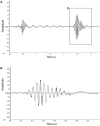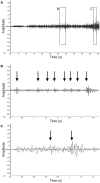The influence of vibratory courtship on female mating behaviour in orb-web spiders (Argiope keyserlingi, Karsch 1878)
- PMID: 23341922
- PMCID: PMC3547032
- DOI: 10.1371/journal.pone.0053057
The influence of vibratory courtship on female mating behaviour in orb-web spiders (Argiope keyserlingi, Karsch 1878)
Abstract
Web-building spiders are important models for sexual selection. While our understanding of post-copulatory mechanisms including sperm competition and cryptic female choice is considerable, our knowledge of courtship and how it influences male and female mating decisions is still extremely poor. Here, we provide the first comprehensive description of male courtship behaviour and vibrations generated in the web by the orb-web spider, Argiope keyserlingi - a recognised model species. We identified three main elements of male courtship: shudders, abdominal wags and mating thread dances (including both plucks and bounces). The vibrations generated by these behaviours are described in detail. Male shuddering behaviour appears to have a strong influence on female latency to mate acceptance, with males that shudder at high rates without compromising shudder duration being preferred. Shuddering behaviour may also mediate female aggressive behaviour, with males that generate long shudders less likely to be cannibalised after copulation. Male abdominal wagging behaviour, however, appears to have only limited influence on female mating decisions. This study provides avenues for future work that synthesises pre- and post-copulatory mechanisms in web-building spiders to generate an all-encompassing model of how sexual selection operates.
Conflict of interest statement
Figures




References
-
- Herberstein ME (2011) Spider Behaviour: Flexibility and versatility. Cambridge: Cambridge University Press.
-
- Herberstein ME, Schneider JM, Uhl G, Michalik P (2011) Sperm dynamics in spiders. Behavioral Ecology 22: 692–695.
-
- Uhl G, Elias DO (2011) Communication. In: Herberstein ME, editor. Spider Behaviour: flexibility and versatility. Cambridge: Cambridge University Press. pp. 127–189.
-
- Watson PJ (1991) Multiple paternity as genetic bet-hedging in female sierra dome spiders, Linyphia litigiosa (Linyphiidae). Animal Behaviour 41: 343–360.
Publication types
MeSH terms
LinkOut - more resources
Full Text Sources
Other Literature Sources

